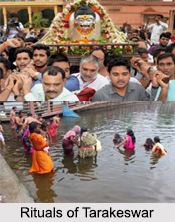 Rituals of Tarakeswer are being performed daily by the pilgrims which are of different types. Tarakeswer is a popular Hindu pilgrimage which owes its name to Taraknath, the presiding deity of this place of pilgrimage. Tarakeshwar Temple is a popular Hindu pilgrimage destination in West Bengal. It is located in the town of Tarakeshwar, in the district of Hooghly in West Bengal.
Rituals of Tarakeswer are being performed daily by the pilgrims which are of different types. Tarakeswer is a popular Hindu pilgrimage which owes its name to Taraknath, the presiding deity of this place of pilgrimage. Tarakeshwar Temple is a popular Hindu pilgrimage destination in West Bengal. It is located in the town of Tarakeshwar, in the district of Hooghly in West Bengal.
Rituals of Tarakeswer
Following are the different rituals of Tarakeswer:
Darshan:This is the simplest of all blessed performances denoting an act of seeing or visiting the deity in order to worship. In proper worship, one has to take a look at the deity first. It is different from an informal visit in as the former is done as parts of worship while the latter is done without performing the worship completely.
Snan: It is a sacred bath in the sacred tank, "Dudhpukur" is required proceeding to performing many of the sacred performances at this pilgrimage centre. The water of the tank is considered holy and estimable by the pilgrims.
Puja: The Puja takes place every day in the temple of Taraknath. Different kinds of worshippers do it in different manners. The management of the temple holds the worship four times a day. The priests offer their personal worships with prayer and incantations, and the pilgrims perform it by offering some articles like "ola", "batasa", "nakuldana" (kinds of sweets), flowers, garlands in an earthen saucer known as "dala" and a small pot full of water of the Ganges mixed with raw milk.
Mundan: This is locally known as "chul-dewa" or ritual offering of hair to Taraknath. It takes place every day at the "kamansala" (tonsuring centre) on a large-scale basis. Mainly the males perform this ritual for fulfilling the vows made in connection with health and well being.
Jal-dhala:Pouring of the holy water of the Ganges over the top of the idol of Taraknath is the most familiar ritual here. While the regular pilgrims pour it after buying the same from the florists` shops, special pilgrims who come on the days of "Sravani" and "Gajan" carry the holy water of the Ganges from Sheoraphuli and trek in groups to the temple to perform the ritual.
Dandi: When a desire is fulfilled and believed to be so through the deity`s grace some devotees undergo an austerity called "dandi". It consists of traversing a part or whole of the way to pilgrimage through following prostrations, each equal to measure of one`s body length and is a general sight at many other centres of pilgrimage in India like Deoghar, Nasik, Pilani, and Puri. Dandi is one of the several forms of austerity performed by the pilgrims of all ages and sex in almost every day but during the month of April.
Dhil-bandha: Although restricted to the women devotees of local and regional areas, some 10-12 persons come here every day to perform a ritual known as "dhil-bandha". As the name suggests, it is an act of tying a lump of hard clay or a potsherd with one`s own hair or with a rope and suspending it to a tree or any object in front of the deity. This is a folk-rite suggesting a sort of contractual relation between the devout and the deity.
Ful-karani: In this ritual, a devotee is required to sit before Lord Taraknath for sometime (6-7 minutes) till a flower rolls down from the deity`s head into his /her palms. A person intending to do the ritual has to observe some restrictions like abstain from using oil, taking meat, fish or egg, making sexual act, and so on from the day prior to the observance of the ritual. A priest is needed to conduct the ritual that assists in making the ritual vow (sankalpa), offers the worship-on behalf of devotees and helps him in pouring the water of the Ganges over the deity`s head. Generally, 10-12 persons of both sexes come daily to do this ritual.
Dharna: Dharna is the most prominent ritual performance that has made this religious centre well-known. It is an act of lying determinedly in front of the deity for days together without any food or drink, expecting the vision of the deity in trance and its direction.





















